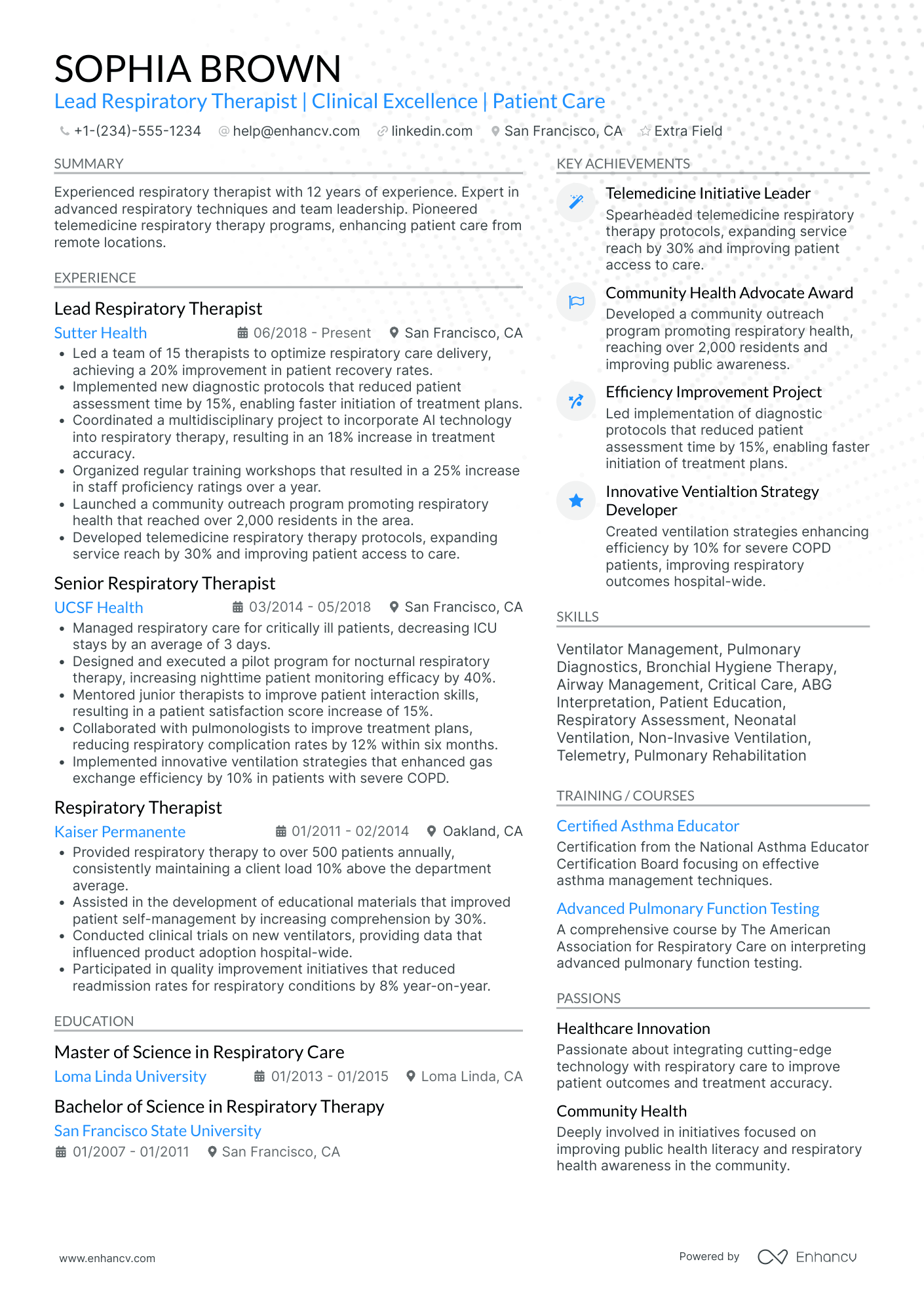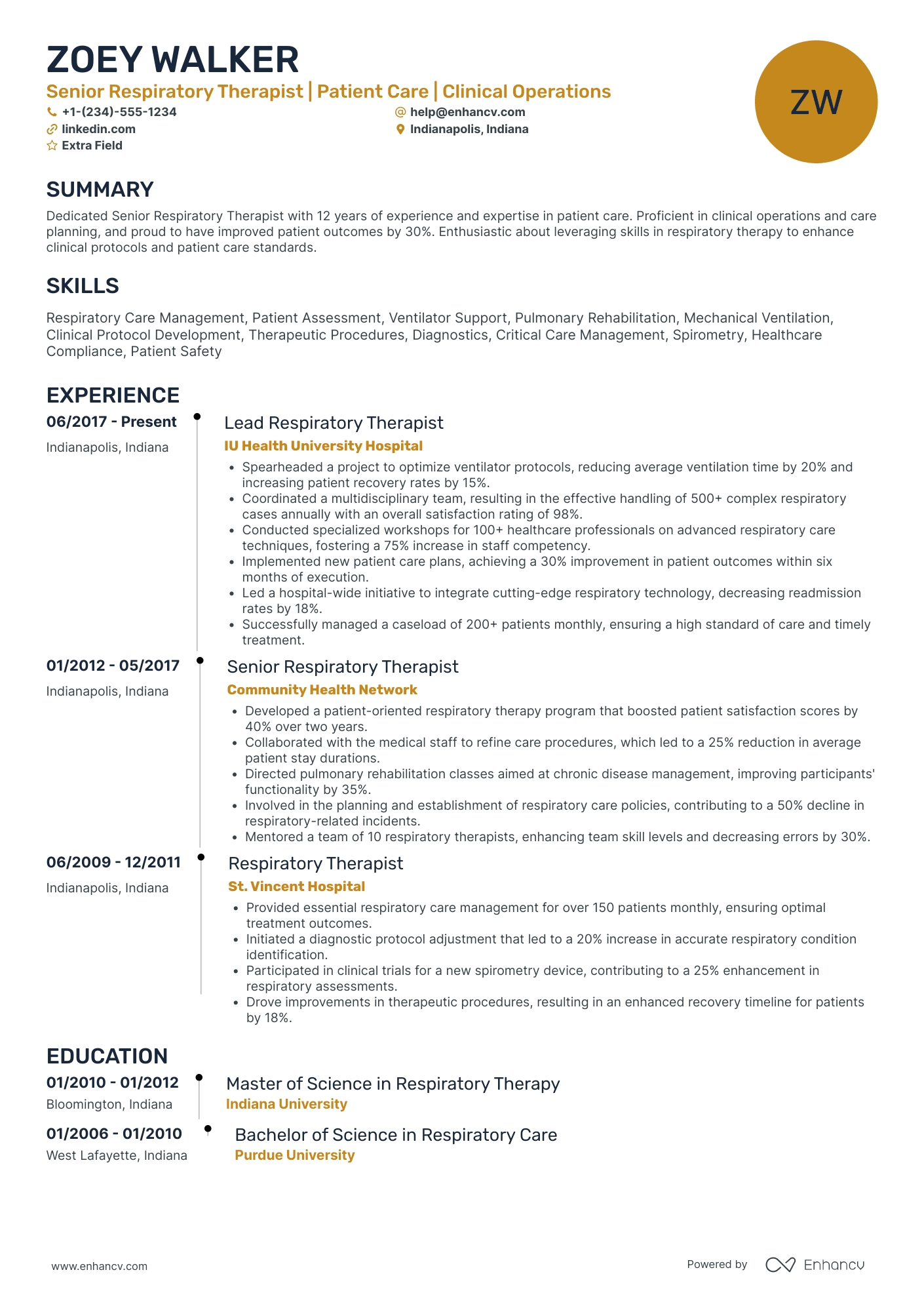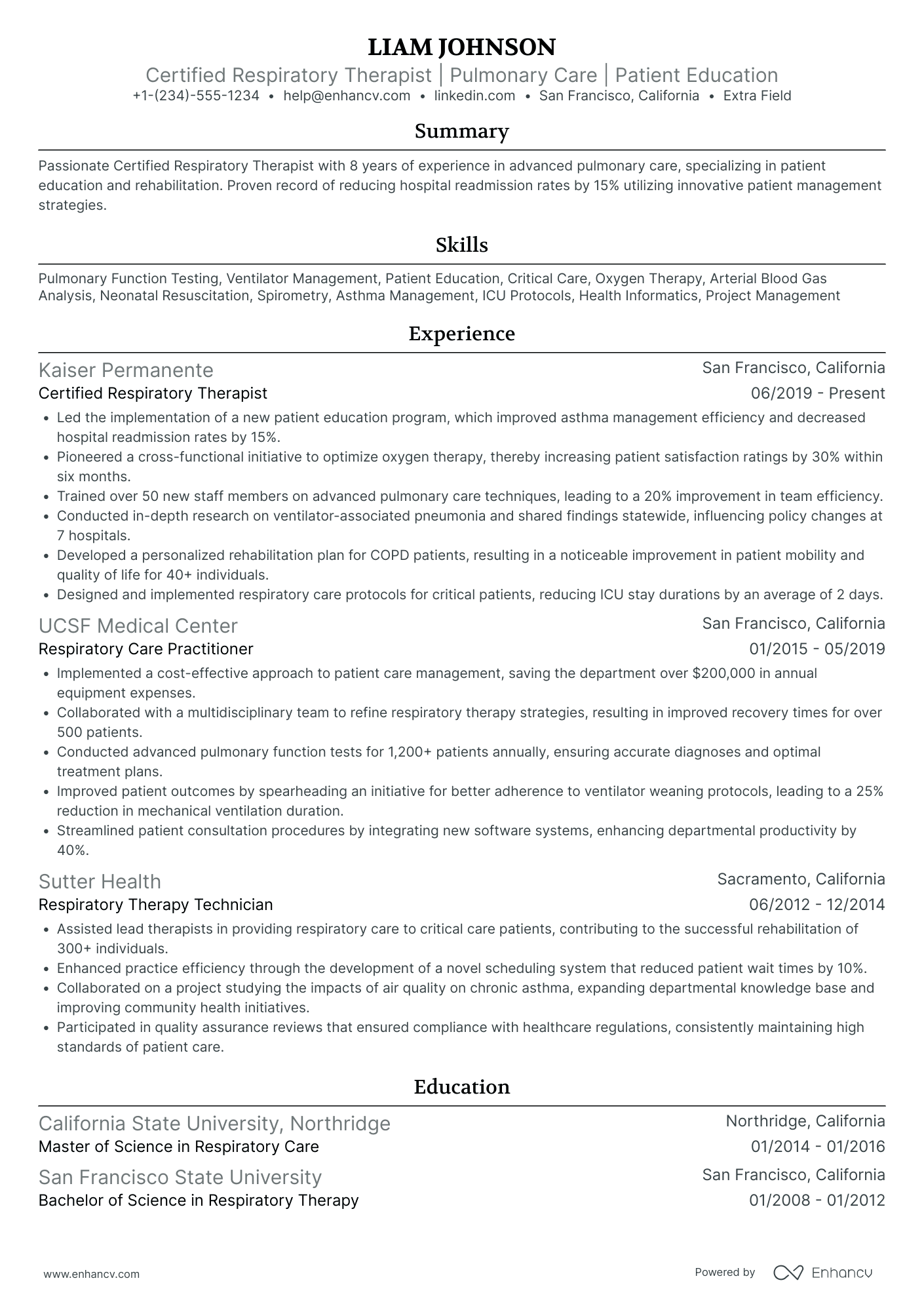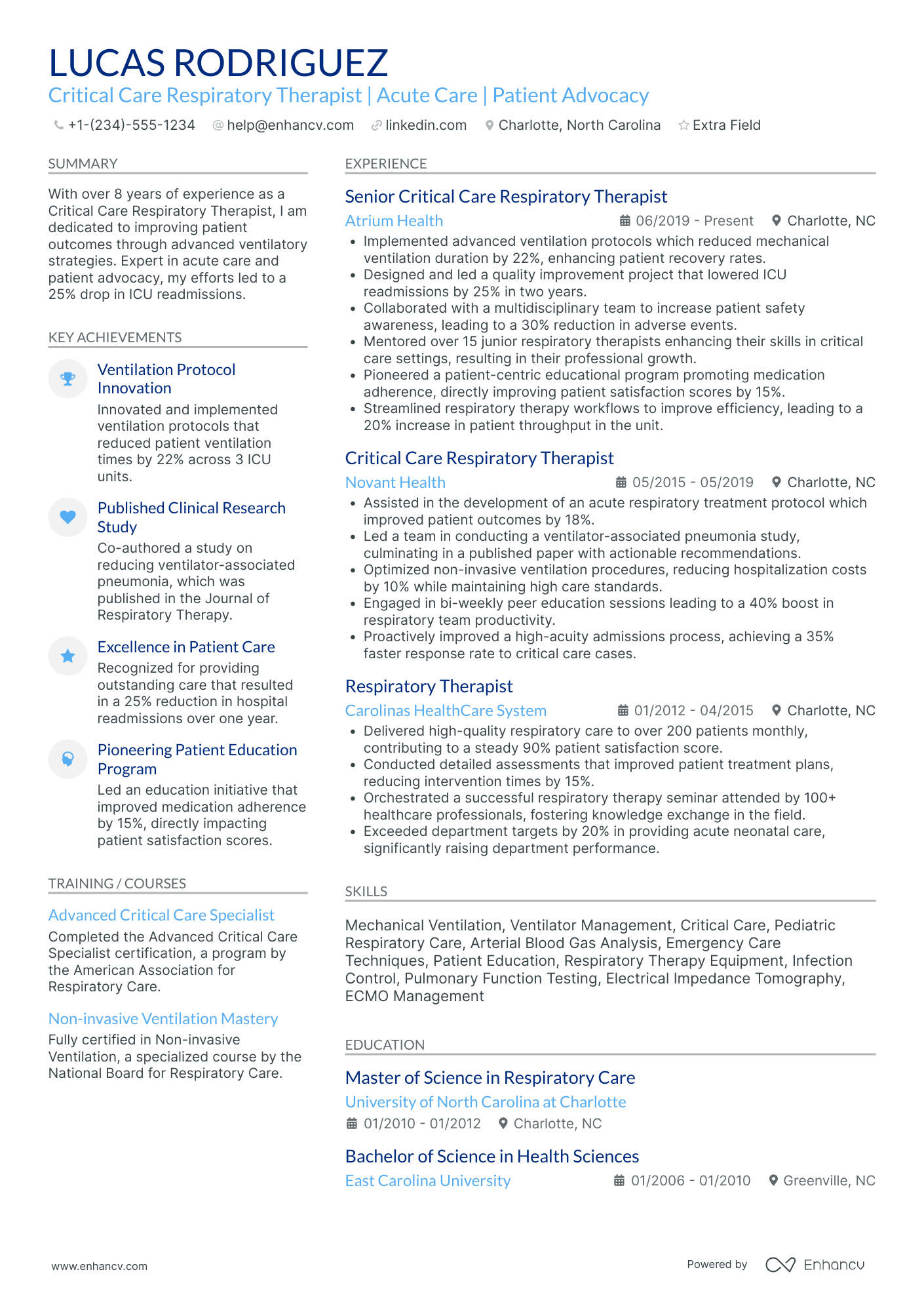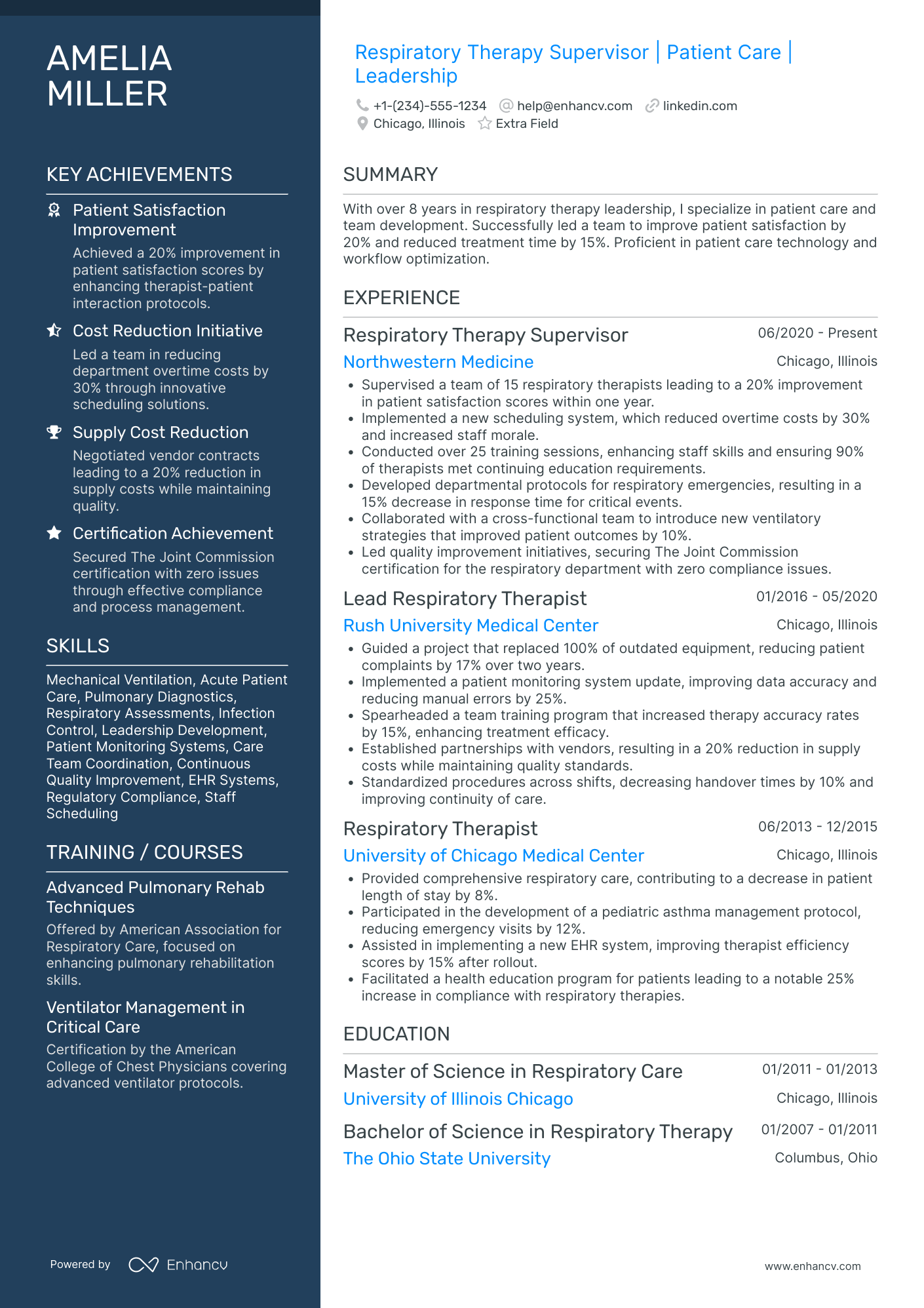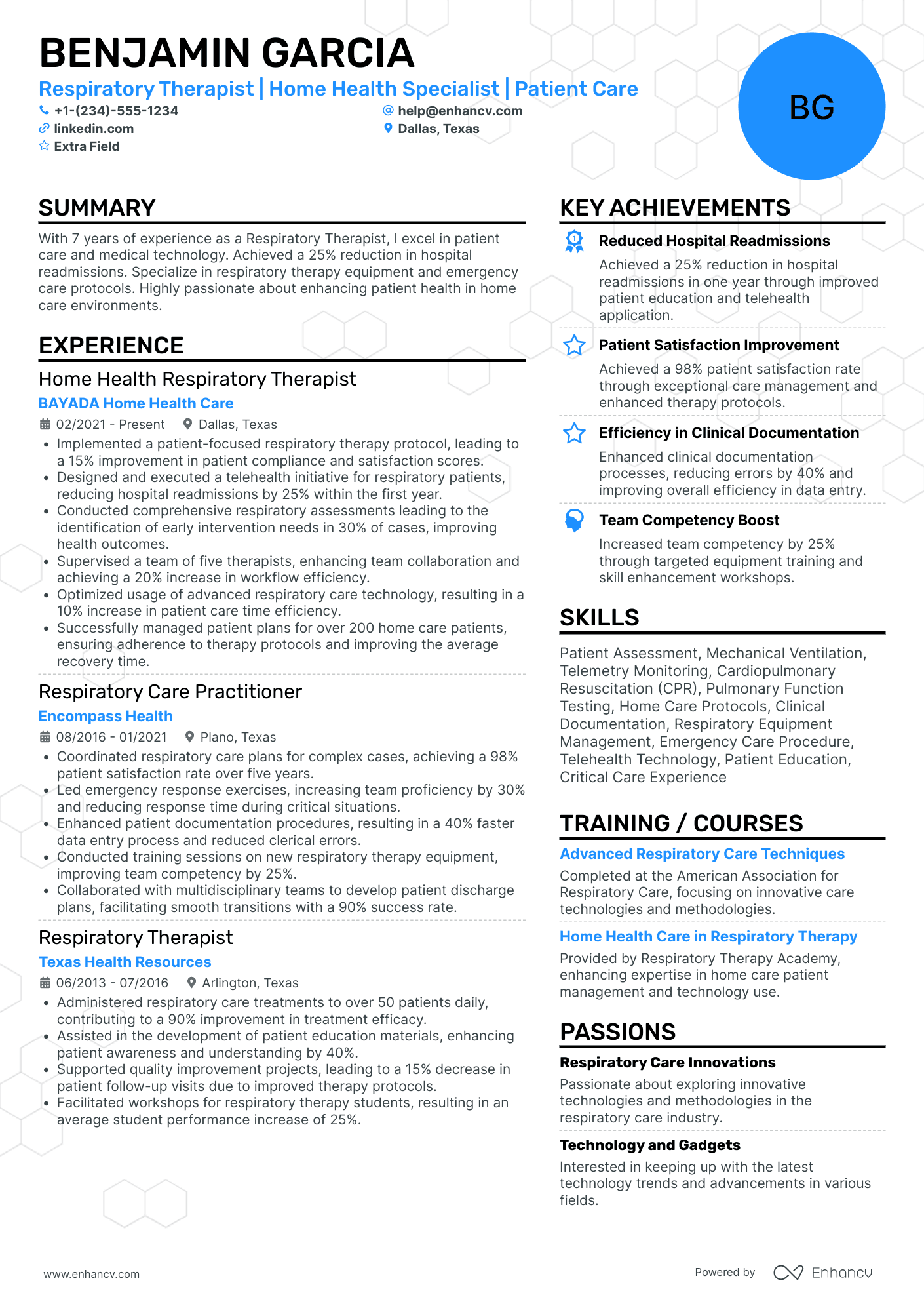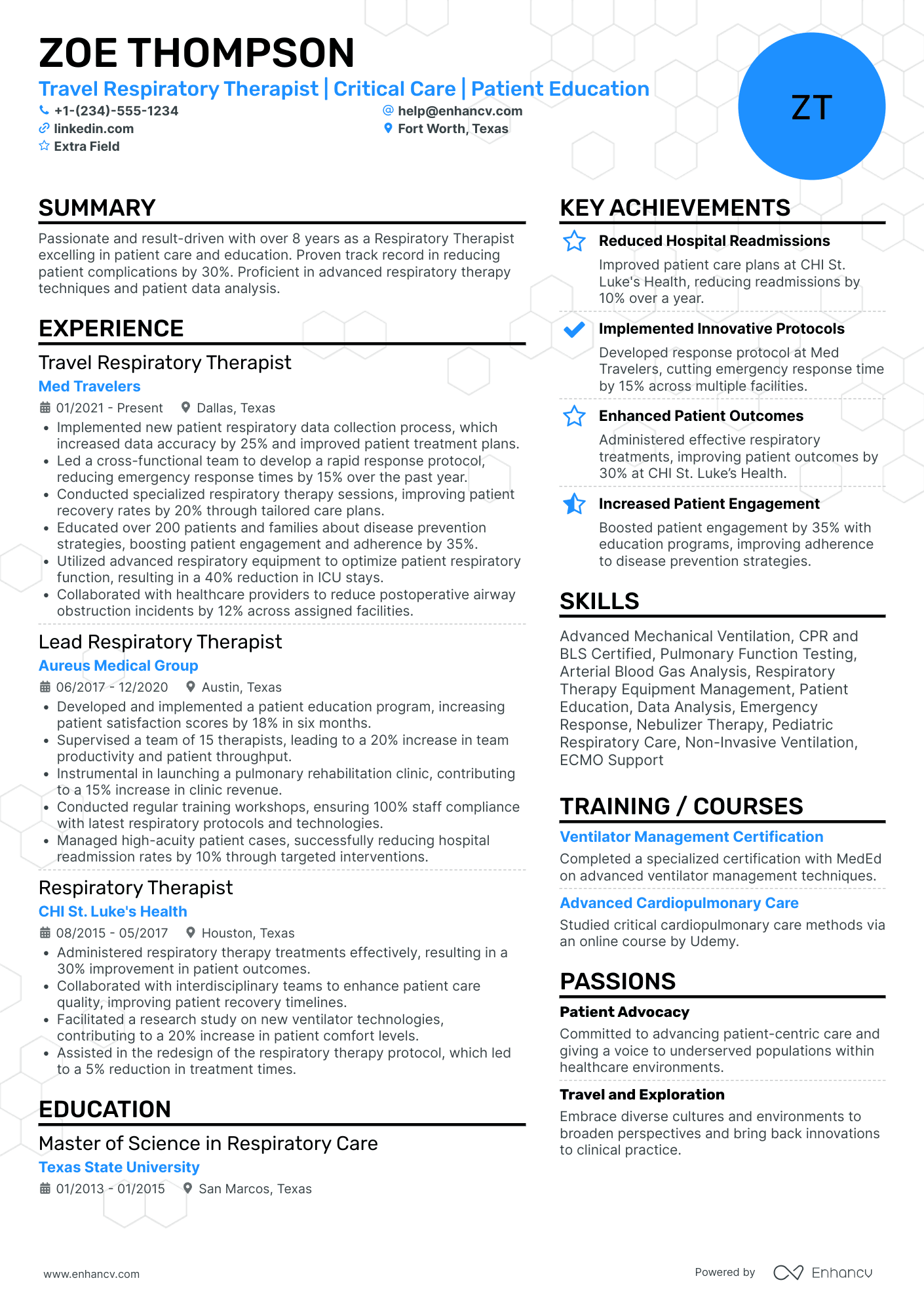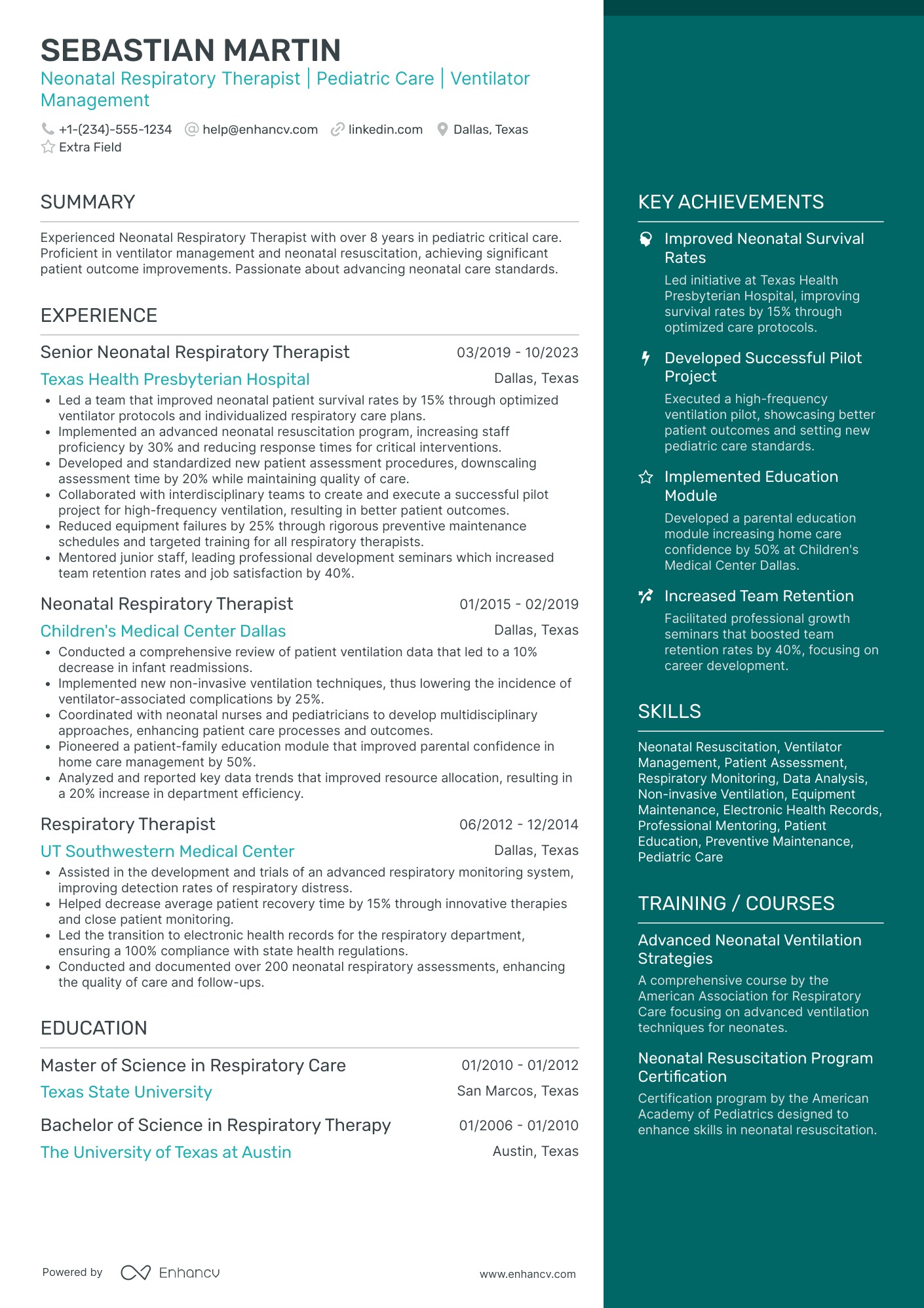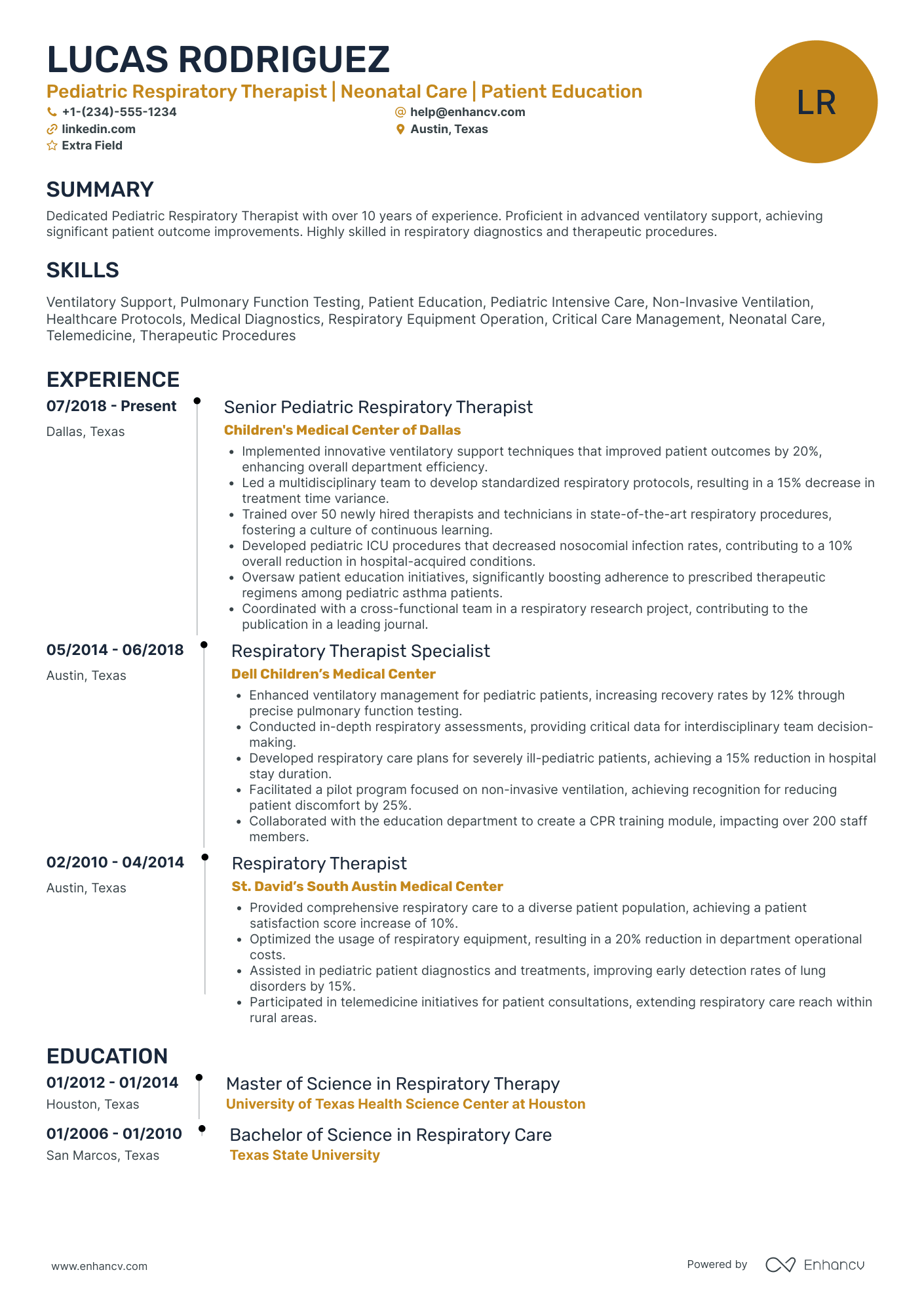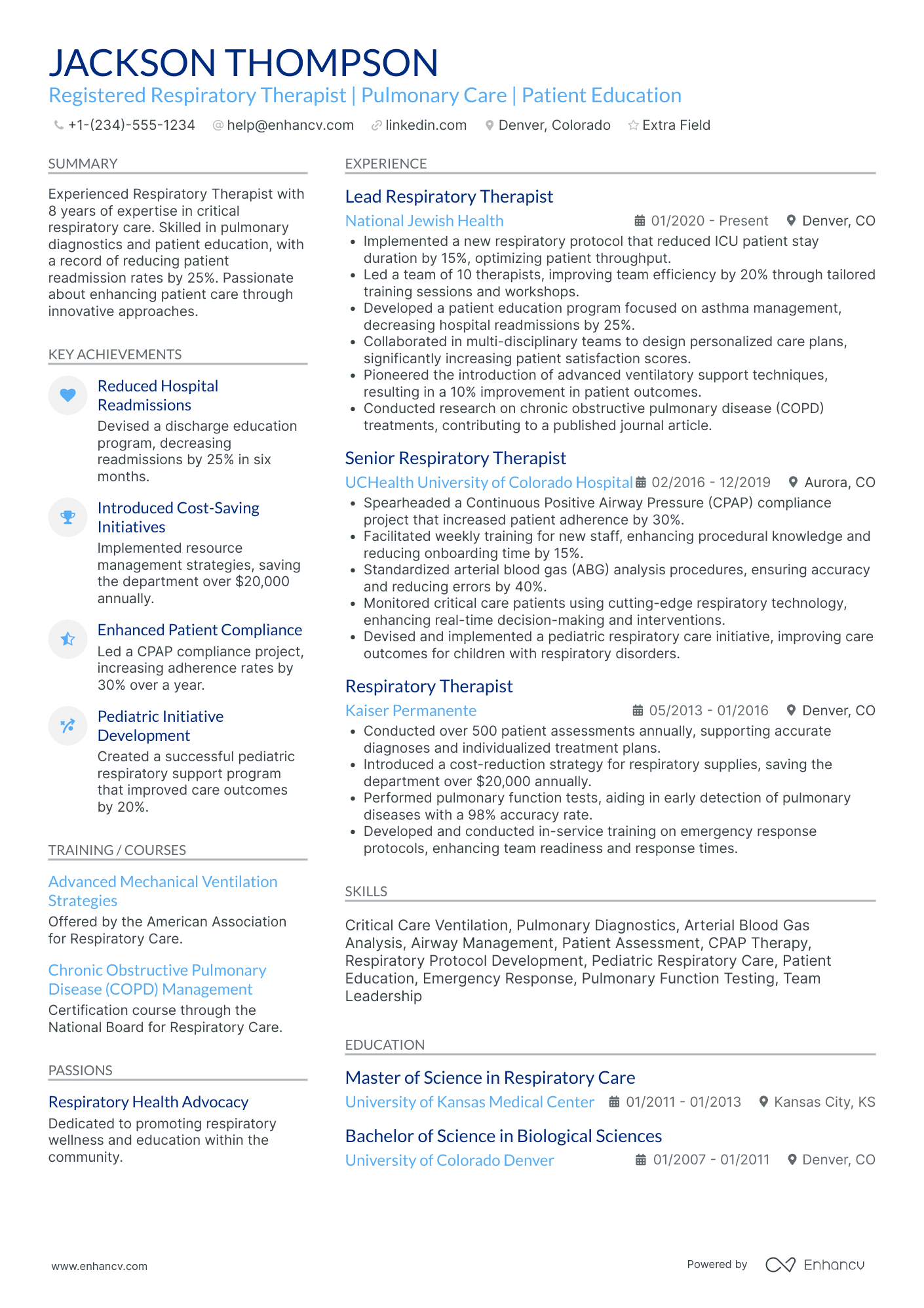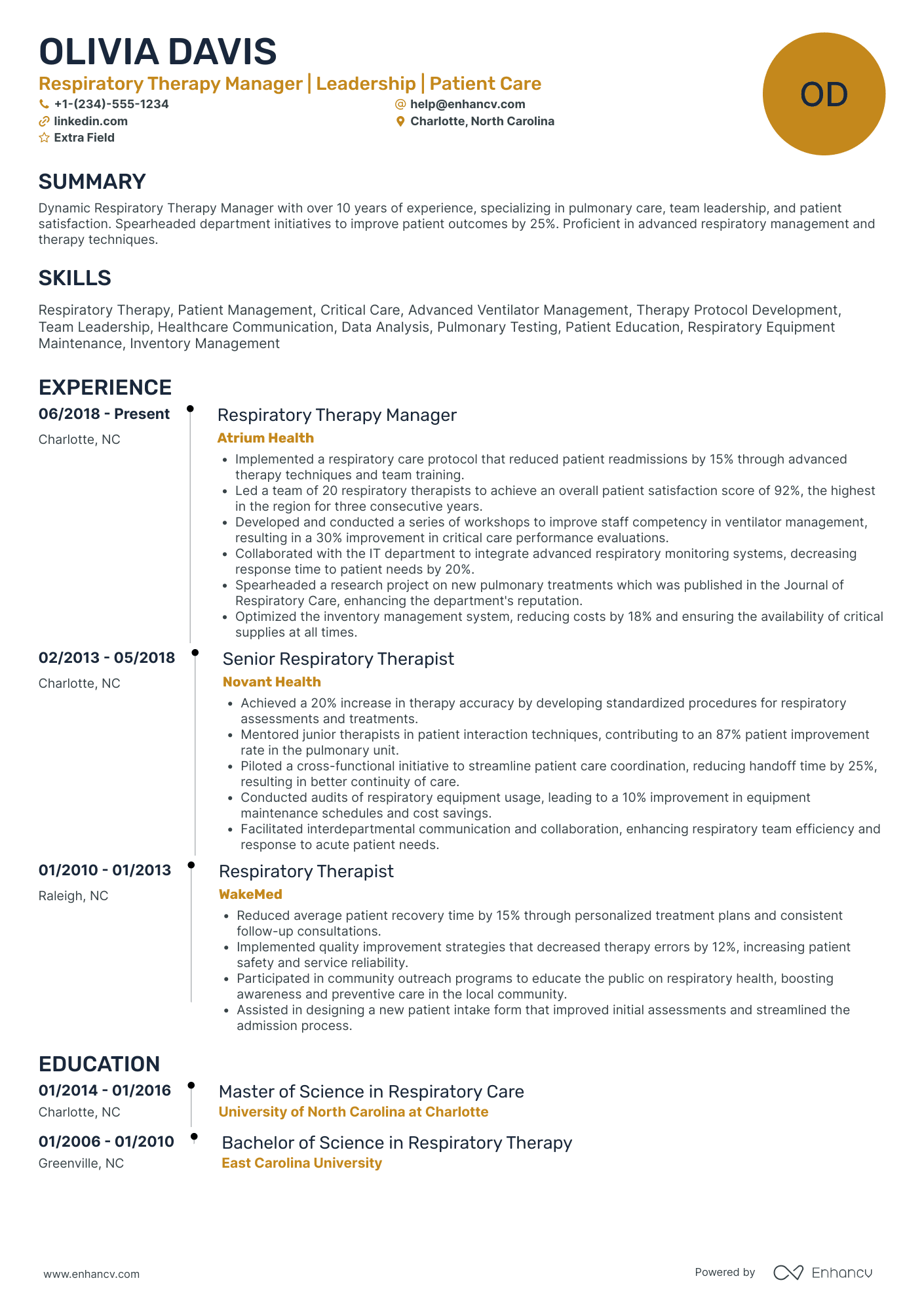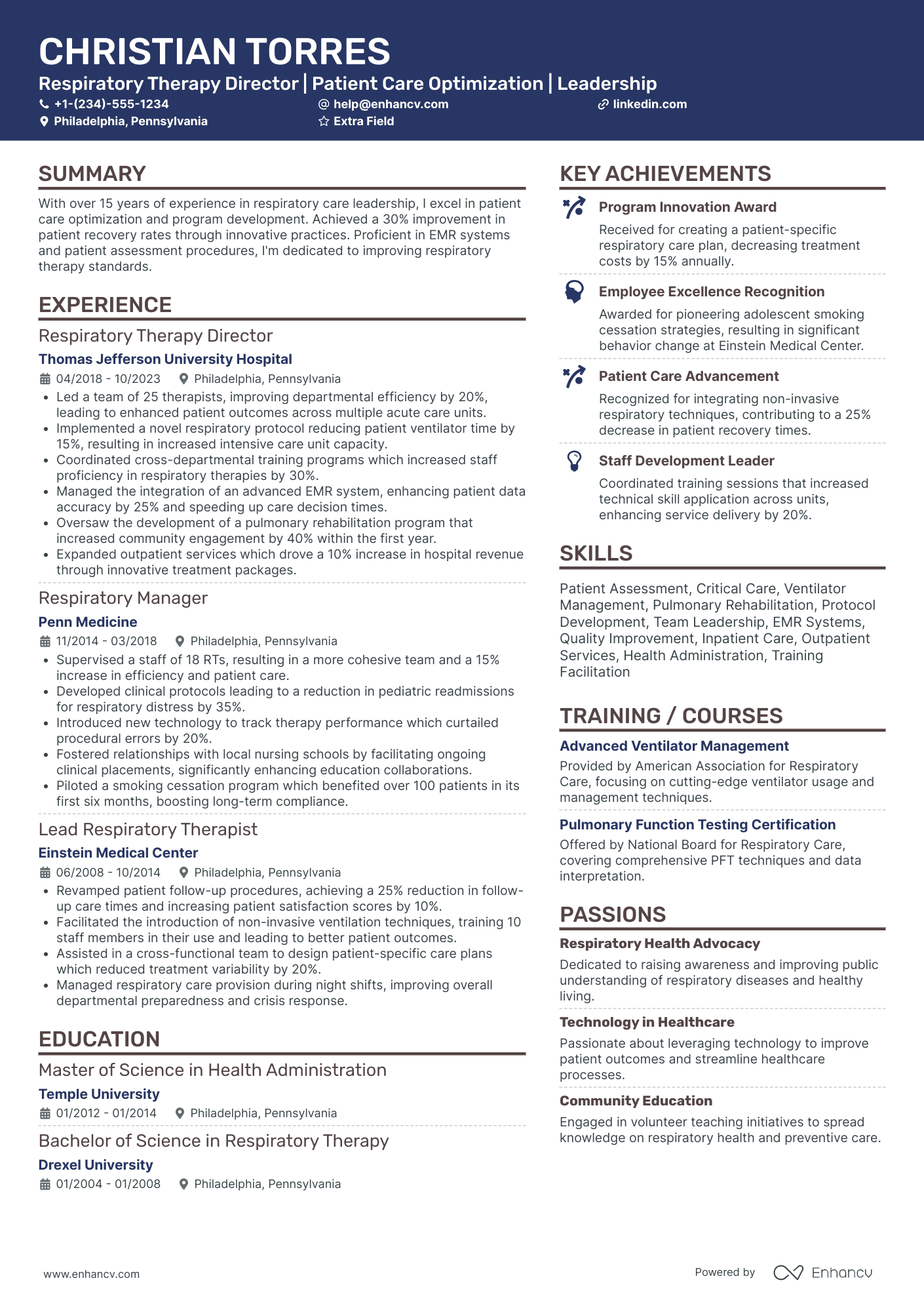Respiratory therapists continue to play a key role in healthcare even after the pandemic as many still suffer from Long COVID symptoms and other chronic lung diseases.
Hence, not only is the demand for pulmonary specialists growing, but the job requirements scope is expanding with each passing year. The perfect respiratory therapist candidate has to demonstrate experience working with a combination of medical equipment in a variety of settings, including critical care.
In this article, we’ll look at:
- Several respiratory therapist resume examples to guide you in your writing process.
- What pitfalls you must avoid when listing your degrees and certifications.
- How to pick a resume format that best represents your specialization and experience.
- How to tailor your application to align with the role demands.
- How to build an eye-catching resume profile.
Explore our other related guides:
- Physical therapist assistant resume
- Physical therapist resume
- Occupational therapist resume
- Therapist resume
- Respiratory therapist cover letter
How to format your respiratory therapist resume
Given that respiratory therapists work in various environments and as part of larger medical teams, your work history is bound to include diverse roles. As such, a common problem among job seekers is to fit every relevant position on your resume and explain how your experience relates to the offered position. That’s often a result of poor layout choices.
Picking a resume format depends on your qualifications and amount of clinical experience. To determine which one will serve you best, let’s review the three most applicable resume formats for respiratory therapists.
Reverse-chronological resume format
If your career is rather linear and you have more than five years of work experience, select the reverse-chronological resume format. This layout allows you to emphasize the current scope of your expertise and demonstrate how you’ve grown over time as a respiratory therapist.
A clear career progression, such as being promoted at the same medical facility, indicates to recruiters your reliability and professionalism. It will also suggest your growth plans as a pulmonary specialist, helping employers see if your goals match their needs and how well you might fit into their facility.
The format is favored by hiring managers and is compatible with Applicant Tracking Systems (ATS).
Hybrid (combination) resume format
It’s difficult to summarize your experience or decide which positions to display on your resume if you have a diverse employment background and your jobs frequently overlap. If this is your case, opt for the hybrid resume format. As its name suggests, the layout offers a balanced overview of your expertise by drawing attention to your most relevant past roles and your top skills.
That’s what makes it more suited for respiratory therapists who have experience both in a clinical environment and as home carers. It’s also perfect for candidates with less than five years of experience because the format will underscore your medical capabilities instead of any gaps in your work history.
Note that you’ll have to be selective about the positions you add to your resume because you won’t have as much space as with the traditional format.
Be mindful of regional differences in resume formats – a Canadian layout, for instance, might vary.
PRO TIP
To make the selection process easier, carefully review the job description. If it’s a position at a health facility, place an emphasis on past long-term roles you’ve held. Then, summarize the rest of your experience in the skills section by listing your tech knowledge and social skills.
Functional resume format
The third layout is the functional resume format. This one best serves novice respiratory therapists with little to no experience. So, if you’ve recently graduated and only have your clinical rotations as practical experience, this is your best bet.
The layout is designed to focus on your education, training, and skills by pushing these sections to the top of your resume. Nevertheless, you should still include any relevant experience you’ve acquired, even if it’s only clinical rotations and volunteering.
PRO TIP
Pay attention when applying through specialized job boards like the Commission on Accreditation for Respiratory Care (CoARC) or American Association for Respiratory Care (AARC).
Although the job boards don’t list any specific resume formatting requirements, some employers may still do.
Once you’ve selected a template for your respiratory therapist resume, it’s time to modify the design and tailor your resume to your desired role. Here is what you must keep in mind:
- Limit your resume to no more than two pages: Remember, a growing demand for respiratory therapists means there’s going to be fierce competition. Plus, recruiters don’t have much time to spend reviewing individual resumes. So, you must detail all pertinent information in a brief and clear manner.
- Tailor your resume for individual roles: While it does take time, aligning your experience to reflect the job ad demands shows recruiters your consideration and attention to detail. Impress them by featuring achievements related to the offered role and prove your value as a respiratory therapist.
- Make full use of your resume header: List your qualifications next to your name, along with your occupation and contact information. Each state has a different set of minimum requirements for respiratory therapists to be considered eligible to practice. So, it’s best you inform recruiters right from the start that you have the necessary qualifications.
- Pick a clean design and an appropriate resume font: Don’t go too overboard with colors or fancy fonts. Make sure your resume is easy to read. Any serif or sans-serif font, such as Raleway and Lato, is a good option. Enhancv’s resume builder provides a library of ATS-friendly fonts, made to meet the strictest recruitment standards.
- Build an ATS-compatible resume: Hiring managers use ATS tools to reduce the amount of resumes they have to check by filtering ineligible candidates. The filters are usually built upon employer-set criteria and formatting preferences, such as resume keywords, design, and resume layout.
- Submit your application as a PDF file, unless requested otherwise: This will preserve the formatting across all devices and platforms. The outdated Word format often relies on users having the same device settings, so that the document is displayed properly.
Is your resume good enough?
Drop your resume here or choose a file. PDF & DOCX only. Max 2MB file size.
Next, divide your resume into sections, starting with the essential ones first. Their order will be based on the format you’ve chosen beforehand.
For a full list of the key sections for your respiratory therapist resume, check out the table below.
The top sections on a respiratory therapist resume:
- Resume summary or objective: Display a focused intent that communicates your commitment to the role by outlining your career goals and aspirations specific to respiratory care.
- Education and certifications: Showcase your academic background as a respiratory therapist to highlight any specialized training or certifications and affirm your medical proficiency.
- Clinical experience: This section should detail your hands-on experience in the respiratory therapy field to demonstrate your practical skills and knowledge in a real-world medical environment.
- Technical skills: Listing specific respiratory equipment and procedures you've been trained in, such as bronchial hygiene or ventilator management, underscores your specialized capabilities.
- Soft skills: Featuring your social abilities will show your emotional intelligence, ability to empathize with patients, and strong interpersonal skills.
Finally, be strategic about the information you share with recruiters. Make sure you emphasize the following:
What recruiters want to see on your resume:
- Practical experience: Employers favor candidates who can demonstrate understanding and efficiency in dealing with respiratory care situations, including operating relevant equipment and dealing with patients.
- Certification in respiratory therapy: It’s important for recruiters to ensure that the applicant has received the necessary specialized training and education and is qualified to perform the role correctly and safely.
- Knowledge and use of medical technology: Recruiters prioritize this as it indicates the candidate's ability to use necessary and possibly life-saving equipment, such as mechanical ventilators and aerosol generators, effectively.
- Interpersonal skills: Because respiratory therapists often deal with a variety of people, including patients, their families, and a team of clinical professionals, they must communicate effectively to provide appropriate treatment and care.
- Continued education or professional development: Recruiters prefer candidates who can show their commitment to staying current in a continually evolving field, demonstrating motivation, engagement, and the professional growth necessary for successful therapy outcomes.
As with your resume, there are certain best practices for every section you should follow to make the most of your application.
Let’s take a look at each segment individually.
How to describe your respiratory therapist resume experience
First on the list is the resume experience section — by far the largest and most significant segment on your resume. It chronicles your work history, along with relevant achievements, training, and any certificates you’ve earned.
But don’t assume that that’s all there is to this section. Its purpose is not only to describe the breadth of your expertise and skills but also to indicate the type of patients you have experience caring for and the workload you’re used to.
Many candidates mistakenly take the “laundry list” approach toward describing their respiratory therapist experience. Health recruiters already have a general idea of your day-to-day duties, that’s why they prioritize actual achievements and results to a list of job tasks.
When you’re certain of the information you want to add to your resume, order the experience entries in reverse chronological order to provide a glimpse of your current respiratory care capabilities. Then for each entry:
- Provide the name of the facility and dates of employment: Hiring managers often compare the length of your employment with the results you’ve achieved during that time to determine the effectiveness of your professional abilities.
- Include a short description of the facility’s main health services: This will inform employers of the type of patients you’re used to looking after. If most of your experience comes from home care services, review the main issues you were responsible for treating. Remember to preserve your patients’ confidentiality.
- Mention the techniques and tools you’ve used in your medical practice: Employers favor candidates who already have hands-on experience with the equipment they have on site. So, ensure you incorporate the names of medical equipment, such as mechanical ventilators or pulmonary life support systems.
- Pick achievements over daily tasks: Hiring managers prefer results-oriented candidates who prioritize their patients’ health. So, it’s best you include as many accomplishments as possible. List them as bullet points and begin each one with an action verb to emphasize your strengths.
- Align your experience with your potential employers’ goals: Although you may be able to predict most of the health facility’s larger plans, each hospital or clinic faces different struggles. Research your potential employer’s current challenges and demonstrate how your expertise and experience can bring value.
- Don’t forget to highlight your professional development: Applicants must showcase their willingness to continuously improve their respiratory care skills, as well as indicate their plans for future career development.
Avoid making your experience entries too overcrowded. To do this:
- Start each entry with an action verb to showcase your proactive approach.
- Limit each entry to a maximum of five bullet points.
- Refrain from decorating your achievements with resume buzzwords.
- Quantify your achievements, when possible.
Have a look at the following respiratory therapist experience section example:
- •Treated over 3000 bariatric patients.
- •Taught patients how to use home oxygen machines.
- •Collaborated with the bariatric and critical care units.
The candidate has made quite a few errors:
- Useless company description: Patients may need rehabilitation therapy for a variety of reasons. The only clue that points to the type of patients the applicant has experience treating is in the bullet points.
- Accent on duties and responsibilities: While the candidate does mention the number of patients they’ve cared for, none of the bullet points include actual achievements.
- Vague experience portrayal: The second entry mentions the use of oxygen machines. However, this type of equipment is usually employed in a home care setting, which contradicts the entire entry.
To avoid any ambiguity and make your experience section, offer more context. Explain how your achievements came about and why your actions were necessary.
Like so:
- •Helped more than 200 bariatric patients stop relying on oxygen tanks and CPAP machines through continuous patient assessment, monitoring, and mentoring.
- •Collaborated with the bariatric and critical care units on helping 350+ patients avoid complications and accelerate their recovery post-gastric bypass surgery.
- •Boosted the overall health of more than 3200 patients with weight and sleep apnea issues by 68% by creating and updating pulmonary treatment plans.
Why this works:
- Pulmonary treatment specialization and skills: The candidate specifies the number and type of patients they’ve treated, as well as the variety of health issues they’ve addressed.
- Team fit: The experience entry highlights how the applicant supported other medical teams and which equipment they were responsible for handling.
- Numbers and data: The candidate provides a good overview of the scope of their responsibilities by sharing the results of their work with the relevant performance metrics.
How to quantify impact on your resume
Speaking of performance metrics, respiratory therapist applicants often overlook data and numbers when building their experience section. Quantifying your achievements is paramount because recruiters evaluate candidates by the data they disclose.
For instance, by listing the number of patients they’ve treated, the applicant demonstrates their multitasking abilities, time management, and organizational skills.
By contrast, if any of the bullet points discuss metrics, such as health improvement rate, this means the candidate is more focused on the type of illnesses they treat.
Depending on your experience and the position requirements, here is how you can tailor your resume to get noticed:
- Demonstrate your capability to handle workload efficiently by including the number of patients you regularly manage or treat.
- Showcase your extensive practical experience by stating the number of specialized respiratory procedures performed.
- Display the effectiveness of your respiratory therapist skills by mentioning any significant percentage of the patient recovery or improvement rate.
- Illustrate the versatility of your technical skills by outlining the number of different respiratory therapy equipment you’re proficient with.
- Prove your commitment to high-quality patient care by detailing any percentage of reduction in medication errors or patient safety incidents under your care.
- Emphasize your teamwork and collaboration skills by listing the number of cross-functional medical teams you’ve collaborated with.
- Indicate your commitment to staying current in the field by noting the frequency or the number of continued education or professional development courses attended.
- Establish your industry tenure and expertise by quantifying the number of years of experience working in respiratory therapy.
How do I write a respiratory therapist resume with no experience
If you’re in the process of crafting a respiratory therapist resume with no experience, you must focus on relevant skills, professional training, and volunteer work you’ve done.
Avoiding the “laundry list” approach may be difficult for recent college grads, but there is a way around it. Go back to your clinical rotation days. Try to remember comments you’ve received about your work from the medical team you’ve worked with, patients, or their families. Think about the impact you’ve made on patients’ overall health. Then, use the feedback to craft your experience section.
Emphasize your ability to actively listen to your patients and take advice and guidance from the medical team.
Here is what you can do:
- Draw inspiration from the little clinical experience you have: Refrain from adding irrelevant positions, such as waitressing or sales work. Arguably, the mentioned occupations involve relationship building and social skills, however, patient care is subject to particular protocols and standards. So it’s important to highlight your ability to properly tend to your patients.
- List your rotations like you would any other work experience: This is the pertinent experience that adds value to your resume because it proves you’re familiar with a hospital setting, the respiratory equipment used during procedures, as well as how to collaborate with other medical professionals.
- Showcase your certifications and any additional training you’ve completed: Some roles demand additional qualifications. These are determined by the variety of health services the facility provides and the types of patients they treat.
- Feature your transferable skills: Although your focus is respiratory therapy and rehabilitation, hiring managers want to see candidates with excellent social talents. Being a pulmonary specialist means you must be equally good at operating the relevant medical equipment and communicating with patients.
Speaking of your professional capabilities, next we’ll review what makes an outstanding skills section.
How to list your hard and soft skills on your resume
The skills section is where you illustrate the scope of your skill set. Most applicants tend to overcrowd this segment by listing as many of their technical abilities as they can to demonstrate their expertise. However, randomly recounting skills won’t impress health recruiters, so you must be strategic. To do this, let’s go back to the basics.
Hard vs soft skills
Generally, your capabilities fall under one of two categories:
- Respiratory therapist hard skills: These encompass your medical knowledge, including rehabilitation and treatment techniques, as well as the ability to operate medical equipment, such as ventilators, CPAP, and BiPAP machines.
- Respiratory therapist soft skills: These are determined by the extent of your emotional intelligence and constitute your ability to empathize with your patients and work well with other medical professionals.
Before you recount any of your talents in the skills section, go over your work history once again. Take note of what achievements you’ve listed and the skills they chronicle. Then, check if the job ad mentions specific abilities you haven’t addressed yet. Once you identify them, describe your skills as you would any of your experience section achievements:
- Begin each entry with an action verb.
- Provide enough context to explain why your accomplishment is worth mentioning.
- Quantify your achievements, if possible.
Below you’ll find some of the currently most sought-after respiratory therapist skills. Do you have any of them? Make sure they’re prominently featured in a dedicated area.
Best hard skills for your respiratory therapist resume
- Mechanical ventilator operation
- Spirometry proficiency
- Intubation expertise
- Arterial blood gas analysis
- CPAP and BiPAP knowledge
- Oxygen therapy administration
- Bronchial hygiene techniques
- Aerosol medication administration
- Advanced cardiovascular life support (ACLS)
- Pulmonary function testing
- Chest physiotherapy techniques
- Neonatal resuscitation
- Invasive mechanical ventilation
- Non-invasive mechanical ventilation
- Critical care medicine
- Pediatric advanced life support (PALS)
- Electronic medical record (EMR) software
- Pulse oximetry monitoring
- Disease management program implementation
- Pulmonary rehabilitation skills
Best soft skills for your respiratory therapist resume
- Excellent communication skills
- Empathy towards patients
- Emotional resilience
- Strong interpersonal skills
- Detail-orientation
- Time management skills
- Patient advocacy skills
- Multitasking abilities
- Problem-solving skills
- Patience and tolerance
- Good decision-making ability
- Ability to work under pressure
- Active listening skills
- Critical thinking skills
- Professionalism in workplace
- Adaptability to change
- Leadership skills
- Teaching and coaching skills
- Flexibility in varied shifts
- Negotiation skills
Remember, whichever skills you choose to include on your resume, don’t overcrowd your resume. Ideally, you should showcase no more than 10 talents.
How to list your certifications and education on your resume
Recruiters are very particular when it comes to candidates having the right credentials. The reason for that is each state has differing requirements for specialists to be eligible to practice.
This means you must frame your education section in a way that informs recruiters you not only have all the necessary qualifications, but they’re in good standing, too.
Before you add all your licenses, check the job description if one certificate is preferred over another. Then, modify your resume by listing the mandatory qualifications first.
Formal education
Your academic background in respiratory care proves you have the relevant medical knowledge to treat your patients with care and understanding. So, it’s crucial you describe the scope of your course and training.
Use the following simple framework to list your degrees:
- Name of your degree and the qualification it grants you.
- Name and location of the accrediting institution.
- Date of course completion or expected date of graduation.
- A few of your top academic achievements.
- Relevant research or coursework you’ve done — especially if you plan to apply for a position at your college’s health center. That way health managers can understand what your professional focus is, as well as your future career plans.
- Your GPA, if you’re a recent college grad and it’s above 3.5
In the end, your education section entries should resemble the one below:
- •Advised and assisted medical specialists at Rush University Medical Center on the pulmonary symptoms management and treatment of 90+ Long COVID patients.
- •Majored in Patient Assessment, Pulmonary Disease, and Critical Respiratory Care.
Certifications
Certifications on a resume demonstrate your knowledge of the latest respiratory disease treatment and rehabilitation techniques. They also serve to prove your commitment to continue developing your skills.
As a pulmonary specialist, you know that it’s your responsibility to keep your licenses up-to-date and in good standing. Oftentimes, applicants forget to keep track of license renewal dates. So, for each of the certificates you list, keep in mind to:
- Provide the name of your certification and the qualifications it grants you.
- Name the issuing organization
- Cite the date you obtained your credentials.
Like so:
If you’re wondering whether any of your certificates is relevant to the role, refer to the job description.
Below you can see which are the currently most popular certifications for respiratory therapists.
Best certifications for your respiratory therapist resume
How to write your respiratory therapist resume summary or objective
An integral part of your respiratory therapist resume is your personal profile. This is a short paragraph at the top of your resume, which provides an overview of your career highlights.
There are two kinds of profiles — the resume summary and the objective.
The first one is suitable for respiratory therapists with more than three years of clinical experience because it includes your:
- Top professional achievements: Make sure to quantify your accomplishments and mention the name of your past employer, if the facility is famous for its pulmonary care.
- Specialization as a pulmonary professional: Some recruiters need to see certain details before they dedicate their time to completely review your resume. For instance, if a neonatal intensive care unit (NICU) is searching for a respiratory therapist, don’t forget to mention you’re a certified Neonatal Respiratory Care Specialist.
- Key respiratory care skills: Indicate what makes you a good pulmonary specialist by listing a few of your technical and social talents.
On the other hand, the resume objective is perfect for novice respiratory therapists because it concentrates more on the potential employer than the candidate. It encompasses your:
- Professional goals: Since non-tenured professionals can’t flaunt their experience, the focus of the objective turns to how the candidate plans to continue growing as a pulmonary specialist.
- Potential value as part of the medical team: The secret to tailoring your resume to a specific position is showing the potential benefits employers can gain from hiring you.
- Relevant skills: To establish yourself as a strong candidate for the role, you must outline your key respiratory care talents.
Let’s look at a few examples to give you an idea of what your resume profile should look like.
Have a look at the respiratory therapist resume objective example below:
This objective won’t impress any recruiters as it:
- Has poor formatting: The candidate doesn’t specify how many years of hands-on experience they have. Also, it’s always a best practice to fully write out any abbreviations to avoid any potential misunderstandings.
- Is missing essential information: The applicant doesn’t explain how their experience or skills were acquired.
- Doesn’t mention the candidate’s value and goals: It’s not certain what the applicant is trying to accomplish or how they want their career to progress in the future. Plus, despite listing a few of their core skills, the objective isn’t tailored in a way that addresses the health facility’s goals.
Taking these notes into account, a much better version of the above resume objective would be:
This one is more informative and will catch the eye of hiring managers because of it:
- Clearly states how much experience the applicant has, as well as the type of patients they specialize in treating.
- Cites a pertinent achievement that describes how the candidate has acquired their clinical experience.
- Provides a balanced list of role-relevant technical and social talents. In addition, the applicant indicates how they plan to continue growing their skill set by earning an advanced-level certificate.
Now, take a look at the following respiratory therapist resume summary example:
This sample won’t make hiring managers stop to read the rest of the resume. That’s because the summary:
- Doesn’t offer enough details: The applicant should have listed at least one or two career achievements to account for the amount of experience reported.
- Offers a vague description of the candidate’s top skills: This is the applicant’s time to shine. As such, they should have used the opportunity to mention at least three of their core respiratory care specialist skills and group them as “other pulmonary rehabilitation techniques”.
- Doesn’t specify the type of patients the candidate has experience with: Employers seek applicants who can adequately treat their patients. Hence, they want to understand how applicants have acquired their skills and what work settings they are used to.
Considering the above notes, here is how the personal profile can be improved:
This resume summary will grab recruiters’ attention because it:
- Highlights professional focus: The applicant references the type of patients they typically care for, as well as the goals they’re working towards.
- Describes a range of respiratory care tech skills: By listing the medical equipment and techniques they are proficient in, the candidate demonstrates how their expertise can bring value to their employer.
- Informs hiring managers of the candidates’ availability: Instead of waiting to reach the interview stage, the applicant has cleverly used the profile as a chance to inform recruiters of their ability to cover specific shifts.
Optimize your resume summary and objective for ATS
Drop your resume here or choose a file.
PDF & DOCX only. Max 2MB file size.
Additional sections for a respiratory therapist resume
If you have some extra space on your resume, you can always include additional relevant information that doesn’t exactly fit in any of the other segments. Here are some ideas for resume sections you can add to your application:
- Volunteer work: Volunteering at a health facility, such as a hospice, is a great way to demonstrate you have a good understanding of how to interact with patients and what to expect when caring for them.
- Membership in relevant industry associations: Given that the medical field is constantly evolving, staying up-to-date on the most innovative respiratory therapy techniques is imperative. A sure way to be in the know is by actively communicating with other industry professionals.
- Personal interests and hobbies: Featuring your hobbies is an excellent way of connecting with your patients if you’re aiming for a home care position.
- References: While this is considered an obsolete section, if you’re a novice respiratory therapist trying to secure a job at your college’s health center, do include references from your professors. This way recruiters will be able to discuss your application directly with someone who is familiar with your abilities and professional growth.
- Languages: Don’t forget to mention, if you’re proficient in foreign languages, or even American Sign Language (ASL). Employers prioritize candidates who have strong communication skills and can care for patients with diverse backgrounds.
Key takeaways
In a nutshell, to build an impressive respiratory therapist resume, remember to:
- Pick a resume format that best reflects your medical knowledge, experience, and expertise.
- Arrange your work history in reverse chronological order, regardless of the resume format you choose.
- List your medical credentials next to your name in the resume header to inform recruiters of the type of licenses you hold.
- Craft a powerful resume objective or summary to provide an overview of your career accomplishments and relevant medical skills.
- Pay special attention to how you build your experience entries when tailoring your resume to a specific position Prioritize quantifying your successes and including keywords from the job description.
- Preserve the confidentiality of your patients when offering context and data about your achievements.
- Explain how your valuable skill set will support your colleagues and benefit potential employers.
Respiratory Therapist resume examples
By Experience
By Role
